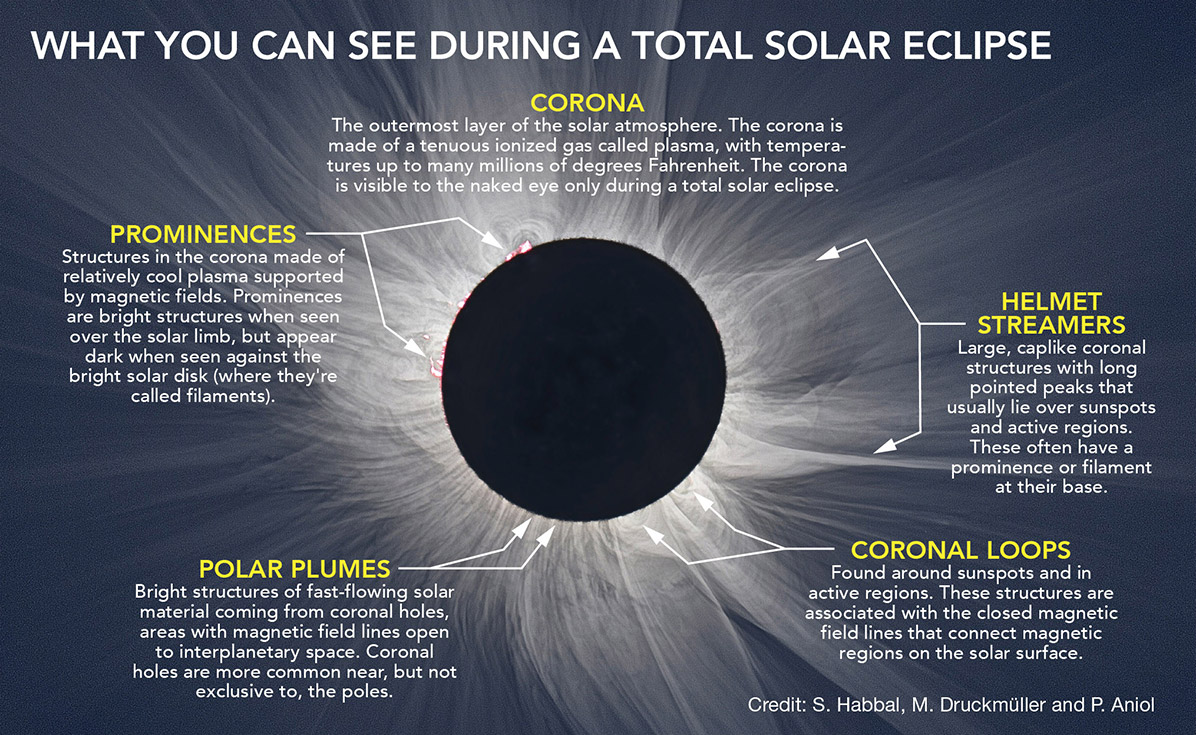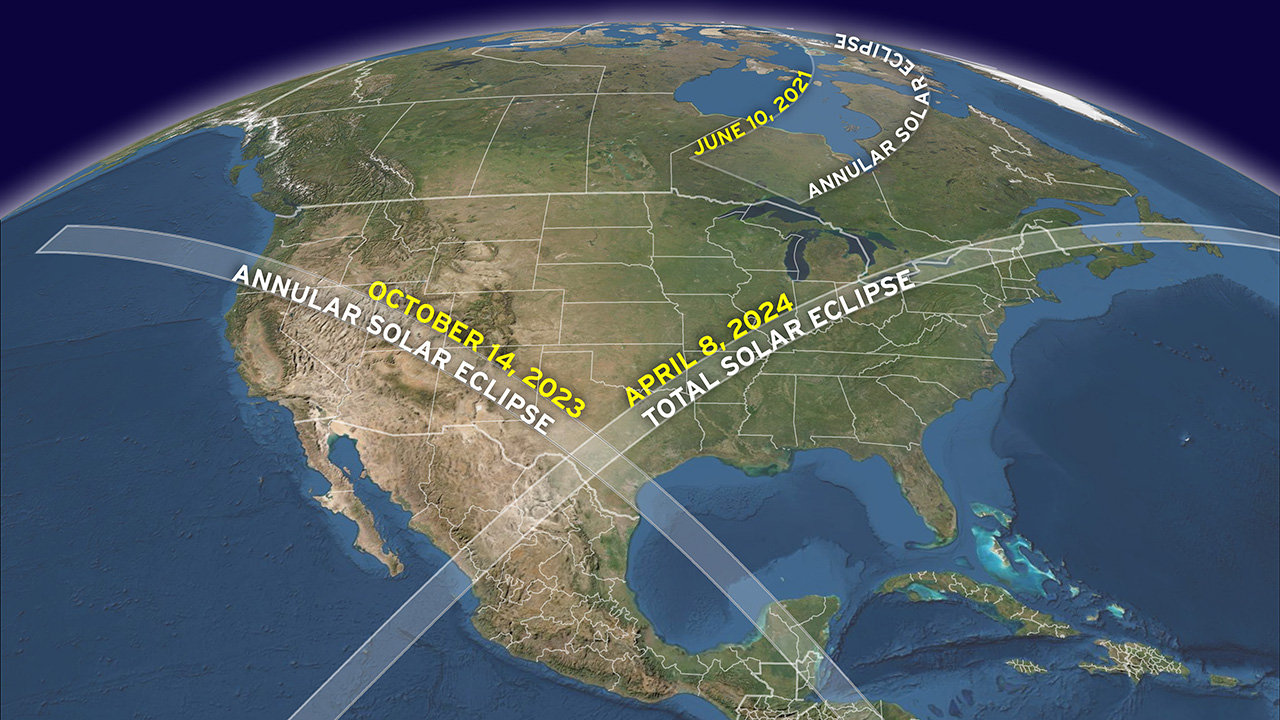Total Solar Eclipses
🌞 🌑 🌎
Occur when the Sun, Moon, and Earth are aligned directly.
People in the path of a total solar eclipse can see the Sun’s corona, the outer atmosphere, which is otherwise usually obscured by the bright face of the Sun. In the meantime, check out some of the recent eclipses…
Photo Credits: Mathew Schwartz
Featured Total Solar Eclipses
TOTAL – Mexico, US & Canada
TOTAL – Antarctica
TOTAL – Chile & Argentina
TOTAL – Chile & Argentina
TOTAL – Across the USA
TOTAL – Micronesia

Credit: Rice Space Institute
A total solar eclipse can last for several hours and totality can range from a few seconds to 7.5 minutes. The longest total solar eclipse of the 21st century took place on July 22, 2009, when totality lasted 6 minutes and 39 seconds!
ECLIPSES HELP US STUDY THE SUN
Studying the Sun during total solar eclipses helps scientists understand the source and behavior of solar radiation that drives space weather near Earth, which can affect the health of astronauts in space and the durability of materials used to build spacecraft.
Similar data will be important in planning NASA’s return of astronauts to the Moon in 2024 and eventual crewed missions to Mars.

Eclipses also set the stage for historic science.
NASA took advantage of the Aug. 21, 2017 eclipse by funding 11 ground-based scientific studies. As our scientists prepare their experiments for next week, we’re looking back to an historic 1860 total solar eclipse, which many think gave humanity our first glimpse of solar storms — called coronal mass ejections — 100 years before scientists first understood what they were.
Scientists observed these eruptions in the 1970s during the beginning of the modern satellite era, when satellites in space were able to capture thousands of images of solar activity that had never been seen before. But in hindsight, scientists realized their satellite images might not be the first record of these solar storms. Hand-drawn records of an 1860 total solar eclipse bore surprising resemblance to these groundbreaking satellite images.
CREDITS: NASA’s Goddard Space Flight Center • Music credits: ‘Electricity Wave’ by Jean-François Berger [SACEM] and ‘Solar Winds’ by Ben Niblett [PRS], Jon Cotton [PRS]
How often do total solar eclipses occur?
On average, every 18 months somewhere on Earth and every 366 years at any one location.
Eclipses can get complicated, so it is easiest to talk about averages. Eclipses occur during eclipse seasons that last about 35 days. During this period, we typically have solar and lunar eclipses on the new and full moons, respectively. These seasons are about 6 months apart, meaning there are usually two solar eclipses during a year. This occurs about 75% of the time. Because these numbers are averages, there can be up to 5 solar eclipses in a year, but this is rare. This last happened in 1935 and will happen again in 2206. The average for total solar eclipses is 1 to 2 years or about 18 months. Two total solar eclipses in one year are also rare but possible. This happened in 1712, 1889 and will happen again in 2057 and 2252.
What causes an eclipse to occur?
Eclipses only occur if the Moon is located within 0.5 degrees of the plane of the ecliptic, on a line that passes through the center of the Sun and the Earth. The Moon travels along an orbit that is inclined by 5 degrees to the ecliptic plane, so there are only two opportunities each month when it passes through the plane of the ecliptic. These points are called the ascending and descending nodes. Eclipses of the Sun only occur if new moon occurs when the Moon is near of one of these nodes. A similar argument explains why lunar eclipses do not occur every full moon at the node opposite the Sun from the Earth.
Why don’t solar eclipses occur every new moon?
Eclipses only occur if the Moon is located within 0.5 degrees of the plane of the ecliptic, on a line that passes through the center of the Sun and the Earth. The Moon travels along an orbit that is inclined by 5 degrees to the ecliptic plane, so there are only two opportunities each month when it passes through the plane of the ecliptic. These points are called the ascending and descending nodes. Eclipses of the Sun only occur if new moon occurs when the Moon is near of one of these nodes. A similar argument explains why lunar eclipses do not occur every full moon at the node opposite the Sun from the Earth.
How many eclipses are there every year?
There are 2-3 eclipses of all kinds each year, and about 2 total solar eclipses every 3 years. During the 5,000-year period from -1999 to +3000 (2000 BCE to 3000 CE), Earth will experience 11,898 eclipses of the Sun. The statistical distribution of eclipse types for this interval is as follows: 4,200 partial eclipses, 3,956 annular eclipses, 3,173 total eclipses and 569 hybrid eclipses. That means that, every 1000 years you have 840 partial eclipses, 791 annular eclipses, 635 total eclipses and 114 hybrid eclipses.
How are total solar eclipses used by scientists?
The most spectacular use has been to study the faint corona of the sun, which can be observed by spacecraft such as the Solar and Heliospheric Observatory (SOHO) by making artificial eclipses, but ground-based telescopes and photography have also made many historical contributions to understanding the shape, structure, and extent of the corona.
Learn more about the corona and the sun’s structure »
During the last century, the precise timing and track of totality could be used to make ultra-precise measurements of the lunar orbit and improve the mathematical model for the gravitational interactions between earth and the moon. In 1919, a total solar eclipse was used to test Einstein’s Theory of General Relativity. Studies of the solar corona during totality were also used to examine its structure and changes in time, and to relate the features seen with details on the solar surface. Currently, there have been attempts to detect interplanetary dust falling into the sun by searching for its faint infrared light beyond the corona. There are also studies of the solar transition region being performed by the glimpses of it provided during totality. Recently, lunar profile data from the NASA LRO mission have been used to predict the exact timing and brilliance of Bailey’s Beads shortly before totality. So new scientific uses for this spectacular phenomenon are found nearly every year!
Also, total solar eclipses have been invaluable in improving our understanding of the lunar orbit. Whether a total solar eclipse occurs at a specific location and time on the surface of Earth depends on the lunar orbit, the motion of the moon along the orbit, the earth-moon distance, and other factors. Sophisticated physics-based computer models have been used for over a century to make accurate predictions of each eclipse to the second, and to the nearest mile on Earth.
The best way to do this is to look at historical sightings of total solar eclipses from centuries or even millennia in the past. These sightings are often made by observers at specific geographic locations and who indicate the time of the eclipse from that location. These distant-in-time observations can be calculated by the modern eclipse models and compared with the historical sighting, then the models can be adjusted by improving the parameters of the physics calculation until an agreement is reached. This process sometimes results in new ‘science’ related to the shape of the moon, or gravitational perturbations in the lunar orbit that can take centuries to build up to measurable effects. For example, in 1989 an astronomical event recorded on a clay tablet found in 1948 among the ruins of the ancient city of Ugarit, Syria, was identified as a description of a total solar eclipse that occurred on 3 May 1375 BCE. The information was used to provide a reference point to establish the long-term evolution of angular momentum in the Earth-Moon system.
How do computers predict eclipses?
Astronomers first have to work out the geometry and mechanics of how the Earth and Moon orbit the Sun under the influences of the gravitational fields of these three bodies. From Newton’s laws of motion, they mathematically work out the motions of these bodies in three-dimensional space, taking into account the fact that these bodies have finite size and are not perfect spheres, and that the Earth and Moon are not homogeneous bodies. From careful observation, they then feed into these complex equations the current positions and speeds of the Earth and Moon, and then program the computer to “integrate” these equations forward or backward in time to construct ephemerides of the relative positions of the Moon and Sun as seen from the vantage point of the Earth. Eclipses are specific configurations of these bodies that can be identified by the computer. Current eclipse forecasts are accurate to less than a minute in time over a span of hundreds of years.
CREDIT: NASA
Eclipse Highlights
CREDIT: Exploratorium
Partial Solar Eclipse
If you’re not in the direct path for an annular eclipse—but still within the outside of the path—this is what you may have seen with proper eye protection.
In some places, viewers didn’t get to see this ring around the Moon. However, they experienced a partial solar eclipse if within range as the map above shows. This happens when the Sun, Moon, and Earth are not exactly lined up. The Sun will appeared to have a dark shadow on only part of its surface. Viewers in parts of the eastern United States and northern Alaska saw a partial solar eclipse on June 10, along with much of Canada and parts of the Caribbean, Europe, Asia, and northern Africa.
In the United States, the partial eclipse was visible along parts of the Southeast, Northeast, Midwest, and in Northern Alaska. In many of these locations, the eclipse will occur before, during, and shortly after sunrise. This meant that viewers will need to get a clear view of the horizon during sunrise in order to see the eclipse.

PROTECT YOUR EYES!
Looking directly at the sun is unsafe except during the brief total phase of a solar eclipse (“totality”), when the moon entirely blocks the sun’s bright face, which will happen only within the narrow path of totality. Be sure to carefully read the details to understand how to protect your eyes! Homemade filters or ordinary sunglasses, even very dark ones, are not safe for looking at the uneclipsed or partially eclipsed Sun.

Mark your calendars! Two upcoming solar eclipses in 2023 & 2024.
After that, you’ll have to travel, because you won’t see another one in the USA until 2045!!

